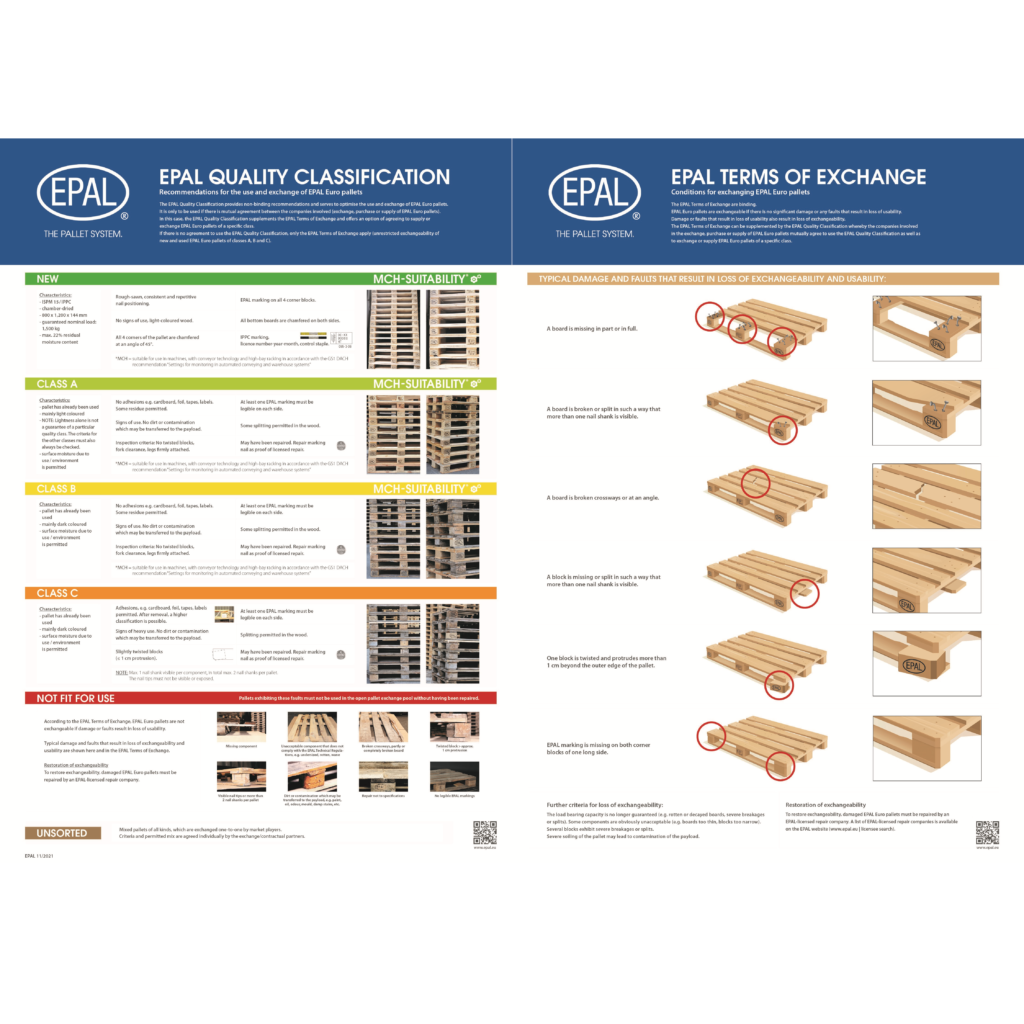New classification enhances use of EPAL pallets
5th November 2021

Under what conditions can an EPAL Euro pallet no longer be exchanged? Is the quality of a Euro pallet reduced by wood splintering or residual labels? How do you know if a pallet is suitable for a high-bay racking system? What is the optimum quality for automated processes? These and many other queries are answered in the EPAL Quality Classification and Terms of Exchange. The new edition of the Quality Classification and Terms of Exchange has now been approved by the EPAL Board.
The European Pallet Association e.V. (EPAL) has revised the Quality Classification and Terms of Exchange in close collaboration with retail, hauliers, pallet service providers and repairers. The new edition of the EPAL Quality Classification still includes the distinction, commonly recognised in the market, between new EPAL Euro pallets, and class A, B and C used EPAL Euro pallets. The new group ‘Unsorted pallets’ covers pallets which are mixed by participants in the EPAL exchange pool and are exchanged one-to-one without having been previously sorted.
The Quality Classification offers EPAL Euro pallet users an easy way of agreeing delivery of a defined quality of used EPAL Euro pallets when buying or exchanging EPAL Euro pallets corresponding to the individual user’s specific requirements. This increases the effective deployment of used EPAL Euro pallets.
Jean-Philippe Gaussorgues, President of EPAL France and Vice President of EPAL, said: “One of the significant strengths of the EPAL Euro pallet exchange pool is the flexible use of EPAL Euro pallets of all ages and quality classes to suit the various needs of different sectors and companies. The new EPAL Quality Classification makes this even easier and even more effective.”
The EPAL Quality Classification has become more and more important in recent years. Originally drafted for the German market in 2011 by EPAL Deutschland and GS1 Germany, the EPAL Quality Classification has been adopted by many National Committees. The increasing number of user enquiries has also been a clear indicator for EPAL of the growing popularity of the Quality Classification.
EPAL has taken the opportunity provided by these enquiries from the market to make the criteria for distinguishing between the quality classes more precise and clearer and to focus more strongly on practical demands and the international use of the Quality Classification. The new edition of the Quality Classification and the Terms of Exchange will be available in more than twenty languages by the end of 2021. The Quality Classification will also be included in the new EPAL app at the start of 2022 to make it even easier to use in practice.
Roman Malicki, President of EPAL Polska and member of the EPAL Board, said: “Cross-border supply chains and the increase in digital pallet management mean the conditions for the use and exchange of EPAL Euro pallets need to be the same in every country and easily understood by all users. The new edition of the Quality Classification and Terms of Exchange approved by all EPAL national committees improves pallet exchange throughout Europe.”
The EPAL Terms of Exchange and the Quality Classification are now published in one document with a new contemporary layout. Smooth exchange of EPAL Euro pallets and certified repair of damaged EPAL Euro pallets need clear rules. The way the EPAL exchange conditions are laid out in the new edition suits these requirements even better.
Pierre Clénin, Managing Director of EPAL Suisse and member of the EPAL Board, added: “The EPAL Euro pallet exchange pool has the EPAL Terms of Exchange at its foundations. Nothing has changed in this respect with this new edition of the Quality Classification and Terms of Exchange. The EPAL Terms of Exchange alone will still apply in the future even if it is not possible to agree a specific quality class according to the EPAL Quality Classification.”
The EPAL Quality Classification and Terms of Exchange are already available to download in many languages from the EPAL website.

